Dual Intel Xeon Platinum 8268 Benchmarks
For this exercise, we are using our legacy Linux-Bench scripts which help us see cross-platform “least common denominator” results we have been using for years as well as several results from our updated Linux-Bench2 scripts. Starting with our 2nd Generation Intel Xeon Scalable benchmarks, we are adding a number of our workload testing features to the mix as the next evolution of our platform.
At this point, our benchmarking sessions take days to run and we are generating well over a thousand data points. We are also running workloads for software companies that want to see how their software works on the latest hardware. As a result, this is a small sample of the data we are collecting and can share publicly. Our position is always that we are happy to provide some free data but we also have services to let companies run their own workloads in our lab, such as with our DemoEval service. What we do provide is an extremely controlled environment where we know every step is exactly the same and each run is done in a real-world data center, not a test bench.
We are going to show off a few results, and highlight a number of interesting data points in this article.
Python Linux 4.4.2 Kernel Compile Benchmark
This is one of the most requested benchmarks for STH over the past few years. The task was simple, we have a standard configuration file, the Linux 4.4.2 kernel from kernel.org, and make the standard auto-generated configuration utilizing every thread in the system. We are expressing results in terms of compiles per hour to make the results easier to read:
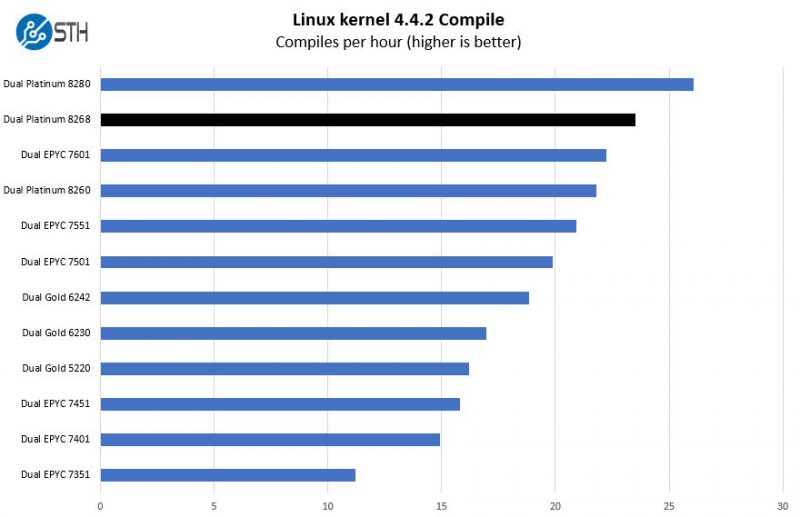
Here we can see the performance come in just between the dual Intel Xeon Platinum 8180 and AMD EPYC 7601 parts. This is a great result for the Intel Xeon Platinum 8268.
c-ray 1.1 Performance
We have been using c-ray for our performance testing for years now. It is a ray tracing benchmark that is extremely popular to show differences in processors under multi-threaded workloads. We are going to use our 8K results which work well at this end of the performance spectrum.
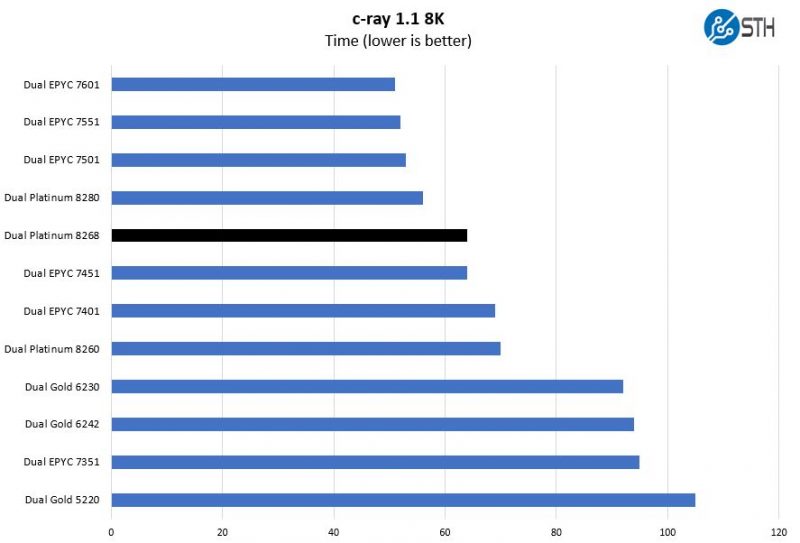
Here the 24 core Intel Xeon Platinum 8268 performs slightly better than the AMD EPYC 7451. This is an architectural win for AMD’s 2017 “Naples” generation. AMD’s chips perform especially well here due to their cache structures. We should mention here that only a quarter after the Intel Xeon Platinum 8268 launch we will see the AMD EPYC 7002 Rome generation with twice as many cores.
7-zip Compression Performance
7-zip is a widely used compression/ decompression program that works cross-platform. We started using the program during our early days with Windows testing. It is now part of Linux-Bench.
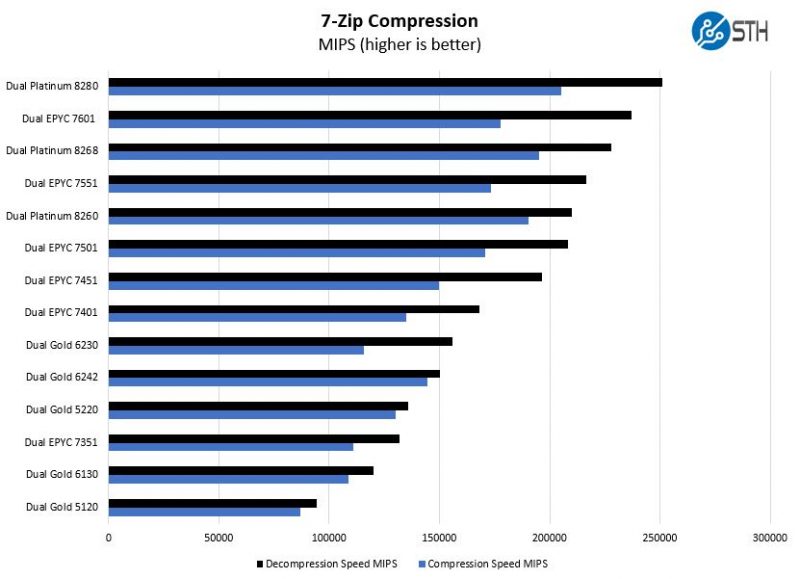
On the compression side, the Intel Xeon Platinum 8268 performs well. We are going to note here that Intel is sticking to AMD EPYC designs using 75% as many cores. Clock speed still matters.
NAMD Performance
NAMD is a molecular modeling benchmark developed by the Theoretical and Computational Biophysics Group in the Beckman Institute for Advanced Science and Technology at the University of Illinois at Urbana-Champaign. More information on the benchmark can be found here. With GROMACS we have been working hard to support Intel’s Skylake AVX-512 and AVX2 supporting AMD Zen architecture. Here are the comparison results for the legacy data set:
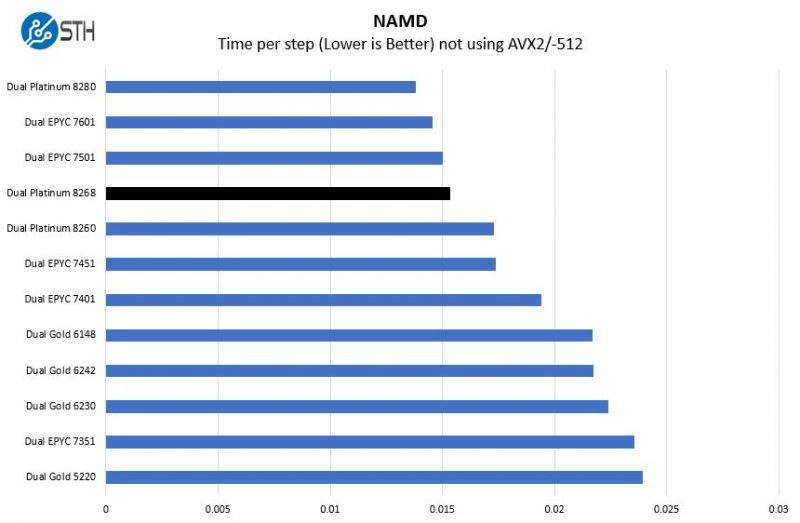
With high clock speeds and a high-TDP, the Intel Xeon Platinum 8268 is able to keep boost clocks giving it very close to Platinum 8280 level performance here.
Again, we are not running these in the highly optimized configurations that AMD and Intel were using around Computex 2019 which stirred up some controversy. See AMD EPYC Rome NAMD and the Intel Xeon Response at Computex 2019.
OpenSSL Performance
OpenSSL is widely used to secure communications between servers. This is an important protocol in many server stacks. We first look at our sign tests:
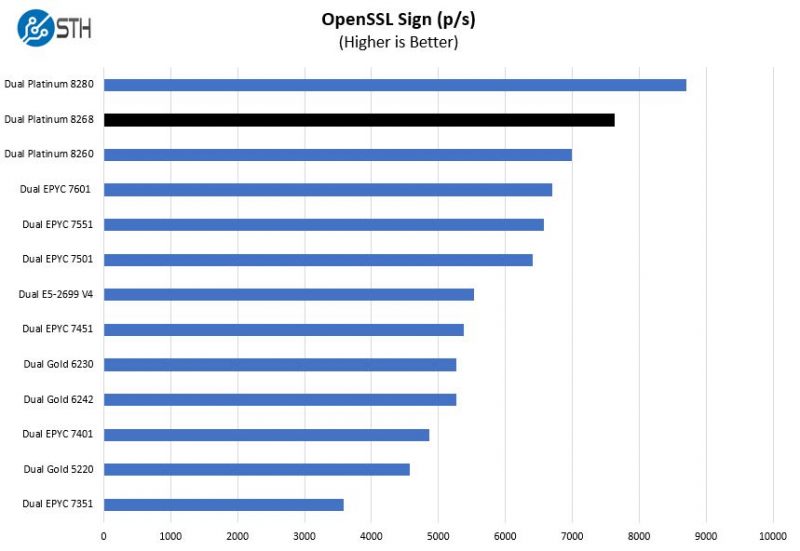
Here are the verify results:
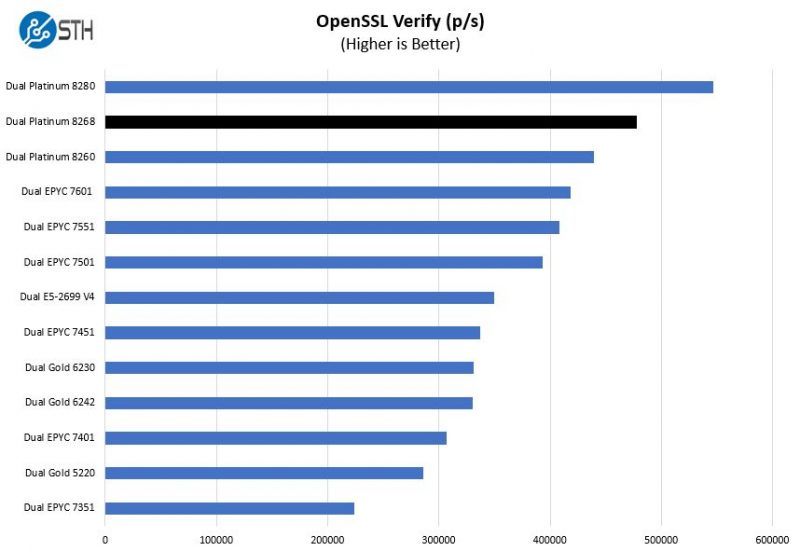
OpenSSL is a foundational technology in enterprise applications. Here we see the Intel Xeon Platinum 8268 notch a fairly clear victory over the Intel Xeon Platinum 8260. The difference here is an increase of 500MHz in the base clock alongside a 40W higher TDP.
UnixBench Dhrystone 2 and Whetstone Benchmarks
Some of the longest-running tests at STH are the venerable UnixBench 5.1.3 Dhrystone 2 and Whetstone results. They are certainly aging, however, we constantly get requests for them, and many angry notes when we leave them out. UnixBench is widely used so we are including it in this data set. Here are the Dhrystone 2 results:
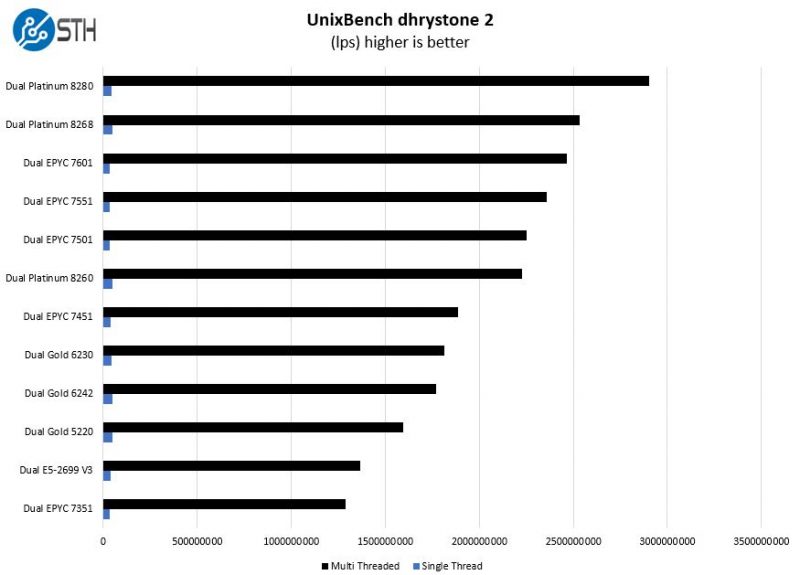
Here are the whetstone results:
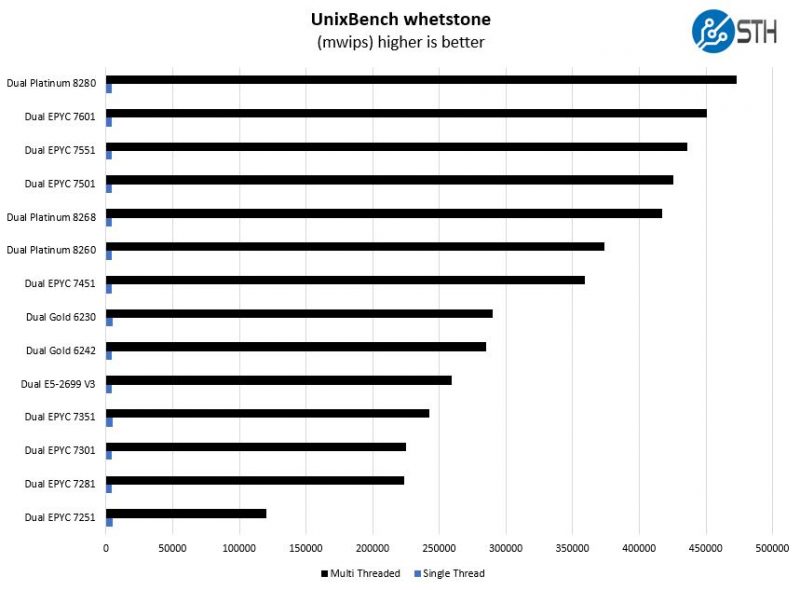
Here the AMD EPYC chips perform relatively well. We again wanted to point out that while the chips may look similar aside from a 500MHz base clock gap, they are not. The Intel Xeon Platinum 8268 and Platinum 8260 have a gap in performance equivalent to about two cores just due to clock speed.
GROMACS STH Small AVX2/ AVX-512 Enabled
We have a small GROMACS molecule simulation we previewed in the first AMD EPYC 7601 Linux benchmarks piece. In Linux-Bench2 we are using a “small” test for single and dual-socket capable machines. Our GROMACS test will use the AVX-512 and AVX2 extensions if available.
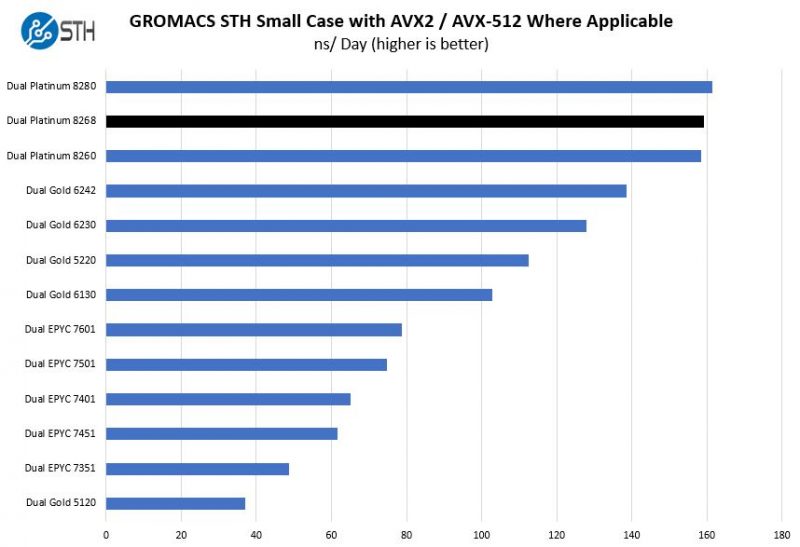
This is perhaps the most interesting result. When we push AVX-512 we are closer than we expected in terms of performance on our STH small case. Intel has a clear advantage here and we are excited to see how that will change in the future.
Chess Benchmarking
Chess is an interesting use case since it has almost unlimited complexity. Over the years, we have received a number of requests to bring back chess benchmarking. We have been profiling systems and are ready to start sharing results:
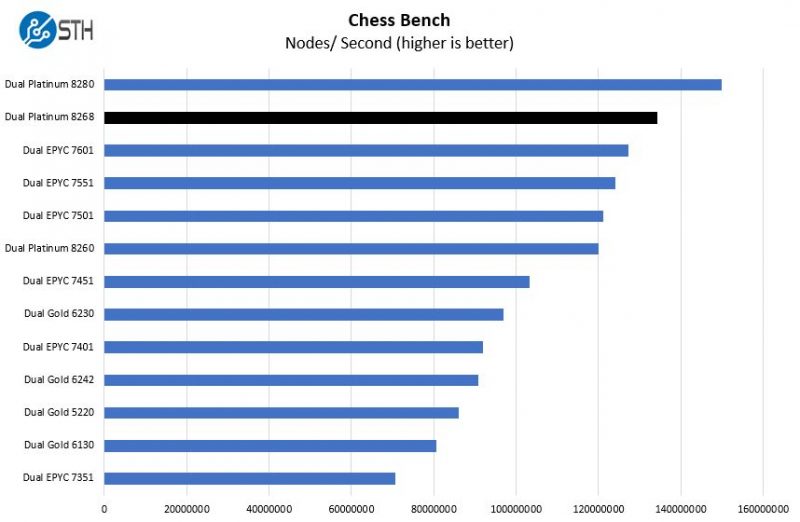
We again see the 24-core Intel Xeon Platinum 8268 sit just between the Platinum 8280 and Platinum 8260 in our charts. It again is ahead of the dual AMD EPYC 7601 configuration. The AMD EPYC 7601 chips have list prices that are closer to the Platinum 8260 but cannot scale to 4-socket.
STH STFB KVM Virtualization Testing
One of the other workloads we wanted to share is from one of our DemoEval customers. We have permission to publish the results, but the application itself being tested is closed source. This is a KVM virtualization-based workload where our client is testing how many VMs it can have online at a given time while completing work under the target SLA. Each VM is a self-contained worker.
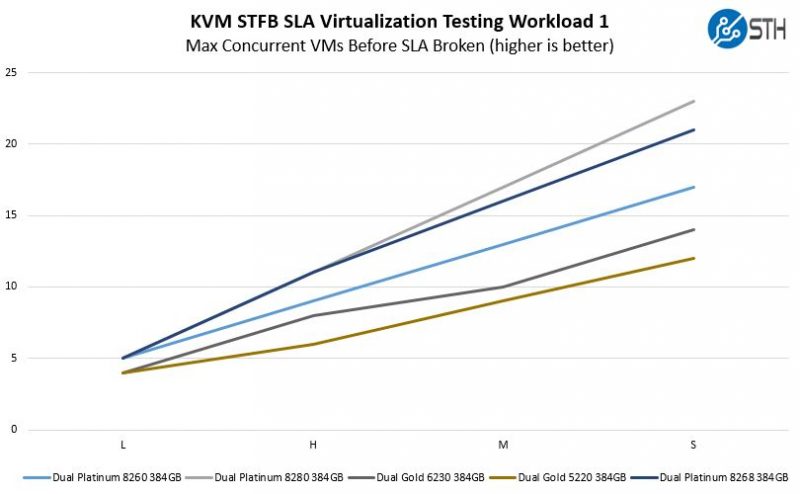
In terms of virtualization performance, the Intel Xeon Platinum 8268 performs very well. We were a bit surprised with how much closer it was to the Platinum 8280 than to the Platinum 8260. Still, a great all-around performance here.
Next, we are going to discuss the solution’s market positioning and then give our final thoughts.




We’re talking $750 per core more to go 8280. Your paying more for those incremental cores than 12 core Xeon Silver. How did we get to this?
The problem AMD is going to have, and probably already has, is software ‘per core’ licensing. It’s not enough to have a bunch more cores, they have to be faster per core. If not you’ll get cool hardware that will absolutely kill you on software costs.
We will have a big discussion of that in our Rome launch.